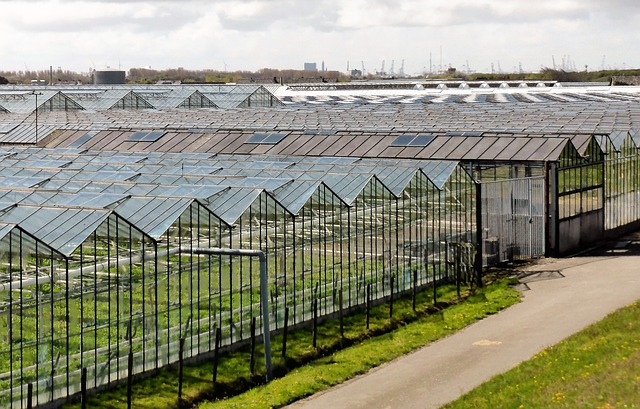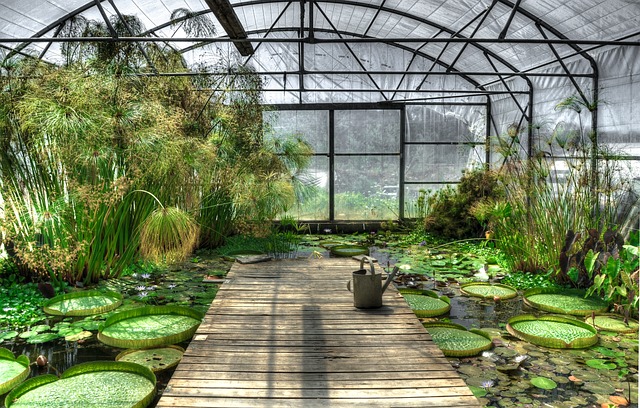As an avid gardening enthusiast, I’ve always been fascinated by the idea of extending the growing season and creating the perfect environment for my plants to thrive. Two popular options that come to mind when considering this are solariums and greenhouses.
A solarium is a room addition in which both the walls and ceilings are enclosed in glass. Unlike a conservatory or sunroom, a solarium’s walls are made up entirely of glass. Solariums are designed to be used during all four seasons of the year, as it has thicker walls than a greenhouse, which allows the sun to warm the space even in colder months. They are intended for human use and comfort.
On the other hand, a greenhouse is a structure that is made entirely of glass or thick, transparent plastic. Unlike solariums and conservatories, their primary function is to house growing plants.
In fact, they often feature regulated climate controls to help manage temperature, humidity, and other factors that influence plant growth. Greenhouses are specifically designed for plant cultivation and protection, providing an ideal environment for various plant species.
What Are the Key Characteristics of Solariums?

Solariums, often referred to as sunrooms or conservatories, are enclosed spaces designed to maximize exposure to natural sunlight.
Description and Characteristics
Walls and Ceilings Enclosed in Glass: Solariums are architectural spaces designed with walls and ceilings entirely made of glass. Furthermore, this extensive use of glass allows abundant natural light to enter, creating a bright and airy atmosphere.
All-Season Usability: Solariums are engineered with thicker walls and insulated glass, making them suitable for year-round use. In addition, they are designed to retain warmth in the winter and stay cool in the summer, providing comfortable living spaces regardless of the weather.
Primary Function
Human Comfort and Recreational Space: The primary function of a solarium is to provide a comfortable and enjoyable space for people. Moreover, it serves as an extension of the living area, offering a unique connection to the outdoors while remaining protected from the elements.
Use Cases and Benefits
Additional Living Space: Solariums are often used as extra living areas. They can serve as lounges, dining rooms, or relaxation spaces where residents can enjoy natural light and scenic views.
Seasonal Transition Areas: Solariums act as transitional spaces between the interior of a home and the outdoor environment. Furthermore, they provide a buffer against harsh weather conditions, allowing residents to experience the changing seasons without leaving the comfort of their home.
Aesthetic and Relaxation Purposes: Solariums are prized for their aesthetic appeal. They offer a serene environment for relaxation and can showcase indoor plants, creating a visually pleasing and calming atmosphere.
What Are the Key Characteristics of Greenhouses?
Greenhouses are specialized structures primarily designed for horticultural purposes, characterized by their transparent or translucent roofing and walls.
Description and Characteristics
Entirely Made of Glass or Transparent Plastic: Greenhouses are constructed using transparent materials such as glass or thick, clear plastic. This design allows sunlight to penetrate and creates a controlled environment inside.
Controlled Climate Environment: Greenhouses are engineered with climate control systems, including ventilation, heating, and cooling, to regulate temperature, humidity, and light. This precision in environmental control is crucial for plant growth.
Primary Function
Plant Cultivation and Protection: The primary purpose of a greenhouse is to provide an ideal environment for growing plants. Moreover, it protects plants from extreme weather conditions, pests, and diseases while promoting healthy growth.
Use Cases and Benefits
Extending the Growing Season: Greenhouses extend the growing season by creating a stable, warmer environment. This allows gardeners to grow crops and plants that might not survive outside during certain times of the year.
Optimizing Plant Growth Conditions: Greenhouses offer control over various environmental factors, including temperature, humidity, and light intensity. Moreover, this precise control allows for the cultivation of a wide range of plant species, from tropical to temperate.
Protection from Adverse Weather, Pests, and Diseases: Generally, greenhouses act as a shield against adverse weather conditions like frost, hail, or excessive rainfall.
Additionally, they also create a barrier against common garden pests and diseases, reducing the need for pesticides and herbicides.
What Are the Key Differences Between Solariums and Greenhouses?

While both solariums and greenhouses offer sheltered environments for plants, they differ in their primary purposes, construction, and functionality.
Purpose and Primary Function :
Solariums
- Purpose: Solariums are primarily designed for human comfort and recreation. They serve as living spaces or extensions to a home, providing a pleasant environment for relaxation and enjoyment.
- Primary Function: The primary function of a solarium is to create a comfortable indoor space that allows residents to experience natural light and outdoor views while remaining protected from the elements. Solariums enhance the quality of life and offer versatile living areas.
Greenhouses:
- Purpose: Greenhouses are specifically designed for plant cultivation and protection. They create controlled microclimates that optimize growing conditions for various plant species.
- Primary Function: The primary function of a greenhouse is to foster plant growth by regulating factors such as temperature, humidity, and light. Furthermore, it provides a sheltered environment where plants can thrive, often extending the growing season.
Structural Differences
Solariums:
- Materials: Solariums feature walls and ceilings that are primarily constructed using glass. They may have some structural elements made of wood, metal, or other materials.
- Design: Solariums have a design that prioritizes aesthetics, with large windows or glass walls to maximize natural light and scenic views.
Greenhouses:
- Materials: Greenhouses are typically constructed using transparent materials like glass or thick, clear plastic. These materials are chosen for their ability to allow sunlight to enter while retaining heat.
- Design: Greenhouses are designed primarily for functionality. Their layout and structure are optimized to provide an ideal growing environment for plants, with minimal attention to aesthetic considerations.
Environmental Control and Regulation
Solariums:
- Climate: Solariums rely on passive heating and cooling mechanisms. Thicker walls and insulated glass help moderate temperature variations, but they do not typically have active climate control systems.
- Ventilation: Solariums may have windows that can be opened for ventilation, but they are not equipped with sophisticated climate control systems.
Greenhouses:
- Climate: Greenhouses are equipped with active climate control systems, including heaters, fans, and ventilation. Additionally, these systems regulate temperature, humidity, and airflow to create the optimal environment for plant growth.
- Precision: Greenhouses provide precise control over environmental conditions, allowing growers to adjust settings to match the specific needs of the plants being cultivated.
Use Cases and Benefits
Solariums:
- Use Cases: Solariums are used as additional living space, often serving as lounges, dining areas, or relaxation zones. They are also employed as transitional areas where residents can enjoy seasonal changes without being exposed to the elements.
- Benefits: Solariums enhance the aesthetic appeal of a property, provide a connection to nature, and create spaces for relaxation and socializing.
Greenhouses:
- Use Cases: Greenhouses are primarily used for the cultivation of plants, including vegetables, flowers, herbs, and exotic species. Moreover, they are essential for commercial and hobbyist growers looking to extend growing seasons or cultivate plants in controlled conditions.
- Benefits: Greenhouses extend the growing season, enable the cultivation of a wider range of plants, protect crops from adverse weather, pests, and diseases, and reduce the need for chemical interventions, making them valuable for agriculture and horticulture.
FAQ’s
Can a solarium be used as a greenhouse?
Solariums are not typically designed for plant cultivation like greenhouses. While some plants can be grown in a solarium, it may not provide the optimal conditions for many plants due to differences in temperature and humidity control.
What is a solarium greenhouse?
A solarium greenhouse is a hybrid structure that combines elements of both a solarium and a greenhouse. It is designed to provide a living space with extensive glass walls while also facilitating plant cultivation. It aims to offer the benefits of both environments.
What is the purpose of a solarium?
The primary purpose of a solarium is to create additional living space that connects people with nature. Solariums are designed for human comfort and relaxation, allowing residents to enjoy natural light and outdoor views year-round.
What is the disadvantage of a solarium?
A disadvantage of solariums is that they can become too hot in the summer and too cold in the winter without proper climate control. They may also require regular cleaning and maintenance due to the large glass surfaces.
Can you grow plants in a solarium?
Yes, you can grow certain plants in a solarium, but it may not provide the precise environmental control needed for all types of plants. Some houseplants and ornamental species can thrive in a solarium with adequate sunlight.
Can you heat a solarium?
Yes, solariums can be heated to maintain a comfortable temperature during colder months. Heating systems, such as radiators or underfloor heating, can be installed to ensure year-round usability.
Do greenhouses need UV light?
Greenhouses require sunlight, which includes UV (ultraviolet) light, for plant growth. UV light is a part of the spectrum that plants utilize for photosynthesis and other physiological processes.
Why are solariums banned?
Solariums are banned or regulated in some regions due to concerns about the health risks associated with indoor tanning. Excessive exposure to UV radiation from tanning beds can increase the risk of skin cancer and other health issues.
Are solariums healthy?
The use of solariums for indoor tanning is generally considered unhealthy due to the increased risk of skin cancer. However, as living spaces, solariums can contribute to well-being by providing natural light and a connection to the outdoors.
Why is it called a solarium?
The term “solarium” is derived from the Latin word “solar,” which means “relating to the sun.” Solariums are named as such because they are designed to maximize exposure to natural sunlight, creating bright and sun-filled living spaces.
Final Words
In conclusion, after a detailed exploration of solariums and greenhouses, it’s evident that these architectural spaces serve distinct purposes and offer unique benefits. Solariums, with their glass-enclosed walls and ceilings, are designed to enhance human comfort and provide recreational spaces. They extend living areas, serve as seasonal transition zones, and create serene environments for relaxation and aesthetics.
On the other hand, greenhouses, entirely made of transparent materials, are meticulously engineered for plant cultivation and protection. They extend growing seasons, optimize growth conditions, and shield plants from adverse weather, pests, and diseases.

